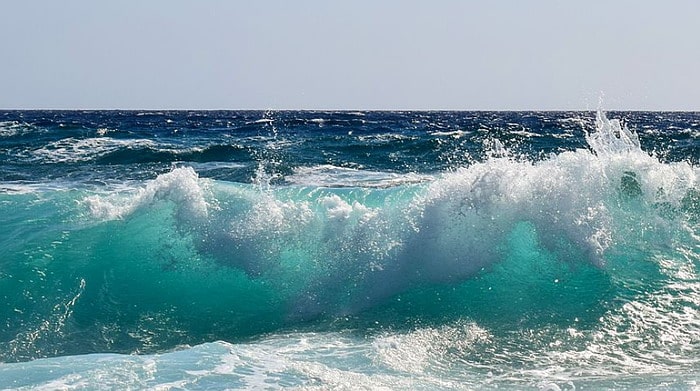What is Wave Energy and Examples

Wave energy is a form of renewable energy that utilizes the power of moving water to generate electricity. It is a clean, efficient and cost-effective way to produce electricity from the ocean’s waves. Wave energy is one of the most promising renewable energy sources for the future because it is constantly available and can be harnessed in a variety of ways.
How is Wave Energy Created?
Wave energy is created when the wind blowing across the surface of the ocean creates waves. These waves have kinetic energy that can be converted into electricity. When a wave moves toward the shore, it pushes against a device that is located near the shore. This device then captures and converts the wave energy into electricity. The electricity is then transmitted to a power grid where it can be used to power homes, businesses and public services.
Examples of Wave Energy
There several technologies used today to generate wave energy.
Wave energy converters (WECs)
Wave energy can be harnessed in a variety of ways. One of the most common methods is called wave energy converters (WECs). WECs are devices that are placed in the ocean and capture wave energy. This energy is then converted into electricity and sent to the power grid. WECs come in a variety of shapes and sizes, from large floating platforms to small buoys.
Wave farms
Another way to capture wave energy is with a wave farm. Wave farms are large structures that are built offshore. They are designed to capture wave energy and convert it into electricity. The electricity is then sent to shore and connected to the power grid. Wave farms are becoming increasingly popular in coastal areas, as they are a cost-effective and reliable way to produce energy.
Harvesting wave energy using tides
A third way to harvest wave energy is with tidal energy. Tidal energy is created by the gravitational pull of the moon and sun on the Earth’s oceans. This creates high and low tides, which can then be used to generate electricity. Tidal energy is a reliable form of energy, as the tides are predictable and can be easily forecasted.
Advantages of Wave Energy
Wave energy, also known as ocean energy, is a promising form of renewable energy that has been gaining popularity in recent years. Wave energy is a renewable energy source that can be used to generate electricity or to pump water for desalination or irrigation. Wave energy is the harnessing of the ocean’s waves to create usable energy, and it has a number of advantages over other forms of renewable energy. Here are some of the advantages of wave energy.
1. Cost-Effective
Wave energy is a cost-effective form of renewable energy. The cost of wave energy is generally lower than that of other forms of renewable energy. This is primarily due to the fact that the technology used to generate wave energy is relatively simple and cost-effective. Additionally, the cost of the energy generated by wave energy may be lower than that of other forms of renewable energy due to the fact that the energy is generated in more consistent amounts.
2. Abundant Resource

Waves can generate huge amounts of clean power to replace conventional energy produced by fossil fuels, image source: Pixabay
The ocean is an abundant resource, and wave energy is a reliable source of energy that can be used to generate electricity. This is because of the fact that the oceans are constantly in motion, which means that wave energy is available year-round. Additionally, with the right technology, wave energy can be generated in any location near the oceans.
3. Clean Energy
Wave energy is a clean form of renewable energy. Unlike other forms of renewable energy, wave energy does not produce any emissions or contribute to global warming. Additionally, wave energy does not require the use of any fuel, which means that it does not create any environmental pollution.
4. Reliable Energy Source
Wave energy is a reliable source of energy. Unlike other forms of renewable energy, such as solar and wind, wave energy is not affected by weather conditions. This means that wave energy can be generated regardless of the weather conditions.
5. Non-Disruptive
Wave energy is a non-disruptive form of renewable energy. Unlike other forms of renewable energy, such as wind turbines, wave energy does not require the construction of large structures, which means that it does not disrupt the environment or the landscape. Additionally, wave energy does not create a lot of noise, unlike other forms of renewable energy.
These advantages make wave energy an attractive option for those looking for a reliable, cost-effective, and clean form of renewable energy. Wave energy has the potential to provide a significant amount of electricity and can be a great alternative to other forms of renewable energy. As the technology continues to improve and become more cost-effective, wave energy will become an increasingly attractive option for those looking for a reliable and clean source of renewable energy.
Disadvantages of Wave Energy
Wave energy is a renewable energy source that is becoming increasingly popular as the world looks for ways to reduce its reliance on fossil fuels. It is a clean, renewable energy source that can be harnessed from the ocean, utilizing the power of the waves to generate electricity. While wave energy does offer a number of advantages, there are also some drawbacks that can make it less attractive than other renewable energy sources.
1. High Costs
One of the major drawbacks of wave energy is its cost. Wave energy is still a relatively new technology, and as such, the cost of its implementation is quite high. This makes it difficult for wave energy to compete with other renewable energy sources such as solar or wind. Additionally, wave energy requires specialized equipment that is not easy to install or maintain. This further adds to the cost of installation.
2. Often Unreliable
Another disadvantage of wave energy is that it is often unreliable. The amount of energy generated is highly dependent on the weather, and wave energy can be unpredictable. This can make it difficult to plan ahead and ensure that the wave energy is available when needed. Additionally, wave energy is only available in certain locations, where there are strong and consistent waves. This means that wave energy is not an option for many locations, which can limit its potential for widespread use.
3. Environmental Impact
Another disadvantage of wave energy is its environmental impact. Wave energy can cause noise pollution, and the wave energy devices can disrupt marine life, such as fish and other aquatic creatures. Additionally, wave energy systems can block light from reaching the ocean floor, which can have a negative impact on marine life. Finally, some wave energy systems can interfere with navigation, making it difficult for ships to navigate safely.
Overall, wave energy does offer some advantages, but it also has some drawbacks that should be taken into consideration. While wave energy is a renewable energy source that can help reduce reliance on fossil fuels, its high cost and potential environmental impacts can limit its potential. Additionally, it can be unreliable and is only available in certain locations. For these reasons, wave energy should be considered carefully before being implemented.
Conclusion
Wave energy is a promising form of renewable energy that has the potential to power millions of homes and businesses around the world. It is clean, reliable and efficient, and can be harnessed in a variety of ways. Wave energy is an important part of the future of renewable energy, and is a key component of the fight against climate change.







